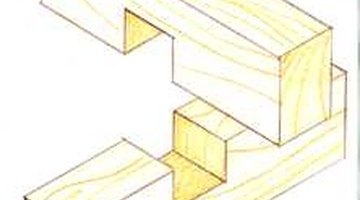How to Cut a Cross-Halving Joint
A cross-halved joint is a type of joint that joins two pieces of timber. The name of the joint indicates where the two pieces of wood will join. Cross- halving involves making a intersection in the center of both pieces of wood. Cutting a cross-halving joint is relatively simple.

Things You Will Need
- Wood chisel
- Circular saw
- Glue
- Nails
- Hammer or mallet
- Hand planer
- Sand paper
- Combination square
- Level
- Tape measure or metal rule
-
Mark the socket lines on the flat surface of the first board. In a cross-halving joint, each piece of wood will contain a socket which will fit together. The first step is to mark where the sockets will be cut. To begin, find the center of the first piece wood. Simply place the second piece on top of the first, so the two intersect. Mark two lines on the bottom piece of wood using the sides of the top piece as a straight edge. Once you have the side lines marked, you must then determine how deep your socket will be.
-
Mark the lines which will determine the depth of your cut. Lay the the first piece of wood on its edge and continue the existing lines halfway down the edge. Make sure you measure so that each line stops exactly at the halfway point into the thickness of the board. Exceeding the halfway point will result in a poorly-fitted and weak joint. Once your lines are marked, square the lines with a combination square.
-
Make the initial cuts. With a circular saw, make a precise cut along the side lines on the face of the board. Make sure you do not cut the opening too large. Position the saw blade so the marked line is slightly to the outside of the cut to ensure you don't make your first cut too wide. You can always trim off excess waste later. If you measured or properly and used the second piece of timber as a guide, the socket should be the same width as the adjoining piece.
-
Use a wood chisel and hammer to remove the rest of the remaining wood from the socket area. Again, make sure you don't exceed the depth of the socket. Measure as you chisel to ensure proper depth.
-
Test the flatness of the socket. Using a try square and level, test that the bottom of the socket is flat and level. If it is not, trim it so it is level using sand paper, chisel and planer. When the socket is cut and smoothed, repeat the above steps on the second piece of wood. When you are finished, the two pieces of timber should lock together, forming a cross-halving joint.
-
Fasten the joint. To ensure your cross-halved joint stays together, use wood glue and nails to keep it together.

Tip
Cross-halving joints can also be cut on the edges of boards. To cut sockets into the edges of boards, follow the steps above, simply use the edge of each board for face cuts. Always measure proper depth and width of the joint according to the thickness of the two pieces of wood. A socket should not be cut deeper than halfway through the width of the boards.
Warning
Always work according to safety regulations. Wear protective covering such as safety glasses when sawing timber.
Tips
- Cross-halving joints can also be cut on the edges of boards. To cut sockets into the edges of boards, follow the steps above, simply use the edge of each board for face cuts.
- Always measure proper depth and width of the joint according to the thickness of the two pieces of wood. A socket should not be cut deeper than halfway through the width of the boards.
Warnings
- Always work according to safety regulations. Wear protective covering such as safety glasses when sawing timber.
Writer Bio
Jim Hagerty is a writer and journalist who began writing professionally in 1996. He has had articles published in the "Rock River Times," "Builder's Journal" and various websites. He earned a Bachelor of Science in public relations and journalism from Northern Michigan University in Marquette.
Photo Credits
- www.crystal-netbook.info
- www.crystal-netbook.info
More Articles



